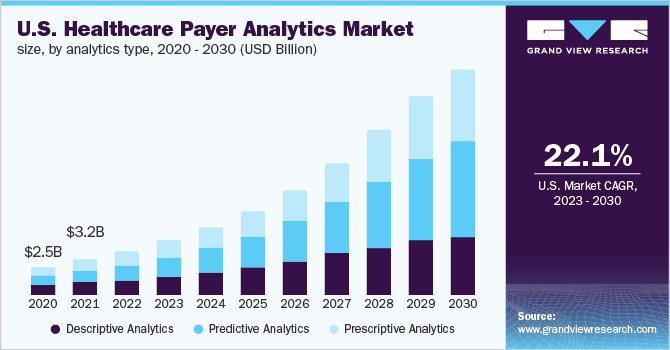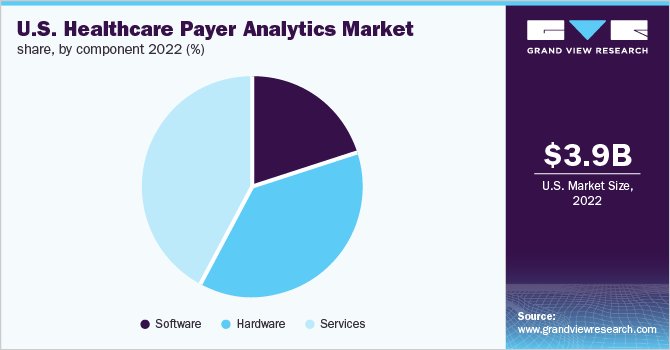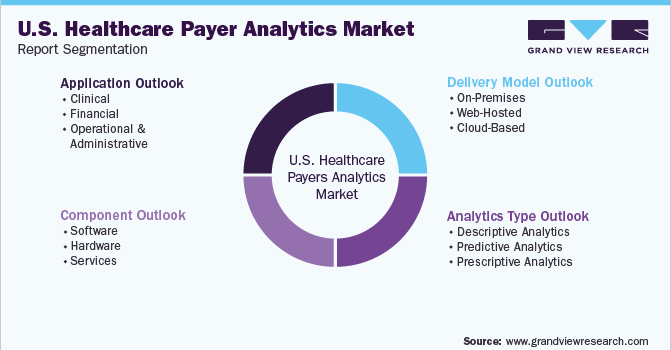- Home
- »
- Healthcare IT
- »
-
U.S. Healthcare Payer Analytics Market Size Report, 2030GVR Report cover
![U.S. Healthcare Payer Analytics Market Size, Share, And Trend Report]()
U.S. Healthcare Payer Analytics Market Size, Share, And Trend Analysis Report By Analytics Type (Descriptive Analytics), By Component (Software), By Delivery Model, By Application, And Segment Forecasts, 2023 - 2030
- Report ID: GVR-4-68039-193-5
- Number of Report Pages: 130
- Format: PDF, Horizon Databook
- Historical Range: 2016 - 2020
- Forecast Period: 2022 - 2030
- Industry: Healthcare
Report Overview
The U.S. healthcare payer analytics market size is valued at USD 3.9 billion as of 2022. It is expected to expand at a compound annual growth rate (CAGR) of 22.1% from 2023 to 2030. The increasing rate of digitization in the healthcare industry is the primary factor driving growth in the analytics for the payers’ market. The use of electronic medical records has been widespread, more so during COVID-19, the increase in adoption rates of such technologies is propelling growth. The digital records and digital technology being adopted by the health system across the U.S. create a huge amount of data that can be used to derive meaningful results and observations to decrease cost, optimize treatment and mitigate risks.

Increase in the healthcare expenditure has risen over the years, according to the National Health Expenditure for 2020 was $4.1 trillion, accounting for 19.7% of the total GDP. The increase is not only supporting the growing infrastructural needs but is also helping in accommodating the increasing patient volumes. The increase in the incidence of diseases and the growing need for better healthcare solutions are key drivers for the growth of the market. There has been a shift in the industry since the passing of the Affordable Care Act, under which the hospital systems are now more focused on value-based care rather than the volume of patients being treated.
The adoption of healthcare analytical solutions has also resulted in massive growth in the market. Advanced analytical techniques are helpful in better decision making, helping administrators to make informed decisions about the business and the patients with healthcare plans, improving their efficiency, and for the overall profitability of the organization. During the pandemic, the adoption of healthcare analytics grew across the industry, this not only help in identifying patients who were at greater risk but also identified potential risks related to the further spread of the virus by ensuring timely treatment of these individuals. Healthcare analytics also helps in analyzing the potential benefits and problems when implementing a new strategy for the organization, determining its chances of success.
The use of big data analytics has also propelled the growth of this market, the data generated with the high volume of patients through electronic records and various other sources like connected technologies and devices. All of this data is raw and unstructured, requiring analysis to derive meaningful observations. The industry is increasingly using business intelligence (BI) tools to make sense of this data. The digital form of data is being continually generated by pharma companies, healthcare providers, payers, patients, etc., use of BI tools not only recommends the best action to take in the treatment process but also helps mitigate the risk of disease.
The COVID-19 pandemic generated a huge opportunity for the healthcare payer analytics market. The industry saw an increase in adoption of digital solutions like telemedicine, adoption of EHRs grew, the plethora of data that was generated during the pandemic was overwhelming even for the healthcare analytics industry, the amount of data generated was unprecedented, and there have been improvements in the record-keeping and data analytics and the industry is continuously evolving and improving to accommodate all the challenges that the pandemic is presenting it with.
Analytics Insights
The descriptive analytics segment had the largest market share of 35.8% in 2022. This analytics type is the most widely used in process optimization as well as administrative activities. This method analyzes past as well as present data to bring forth meaningful information or a pattern that can significantly impact future decisions. Specifically, for COVID, it has been used to determine how contagious the virus is by studying the rate of positive COVID tests in a given population over a specific time.
The fastest growing segment is predictive analysis, with a CAGR of 26.4% for the forecast period. Predictive data analytics helps care providers to course the best treatment plan for the patients for better outcomes. Personalized care has been gaining a lot of momentum and predictive analysis has proved useful to understand the specific treatment needs of each patient and enables providers to offer the best treatment plans.
Delivery Model Insights
On-premises delivery model dominated the market with a share of 48.6% in 2022. The healthcare industry is evolving in terms of technology, the use of on-premise models has largely been adopted by the industry, and it has many benefits like better access to data, reduced chances of theft of data, reduced cost, and ease of maintenance. On-premises storing of data has the biggest downside of storage capacity limitations making it a huge hurdle in the growth of this segment.
Cloud-based storage and improvement in privacy concerns have made the cloud-based delivery model the fastest-growing sub-segment anticipated to register the fastest growth rate of 25.7%. The rapid adoption of this delivery model by healthcare organizations has resulted in the rapid growth of the sub-segment. The biggest hindrance posed by the on-premise storage is easily managed by a cloud-based solution, since there are no capacity limitations, the data that can be stored is huge and requires minimal setup by the organization, which has resulted in the growth of the market.
Application Insights
The financial application segment dominated the market with a revenue share of 35.7% in 2022, the increased rate of adoption by government and private facilities alike has been the main factor driving the growth of the market. A number of financial applications can save millions in fraudulent claims, claims settlement, and risk analysis for insurance companies. According to National Healthcare Anti-Fraud Association, healthcare frauds in the U.S. amount to nearly $80 billion per year. The use of healthcare analytics can not only reduce incidences of fraud but can also optimize insurance plans and recover losses.
Financial is anticipated to register the fastest growth rate of 23.1%, it is expected to grow at a substantial rate during the forecast period. Increased implications related to financial aspects have been a primary driving factor for the growth of the healthcare payer analytics market. With the help of this application payers which includes insurance companies, third-party payers, etc. can optimize their plans for the maximum benefit of patients and also save funds by recognizing fraudulent claims.
Component Insights
In the component segment, the services had the largest market share of 41.8% as of 2021. Outsourcing of data has been the recent trend in this segment, this not only offers the establishments to get the data analyzed from industry experts but also saves the cost of training and educating their staff to do the same.

In 2022, services accounted for the largest revenue share of 42.0%, the services segment was recorded to have the fastest growth rate of 22.7%, the lack of appropriate staff for analytics in the industry is a major driver for the growth of this segment. Due to this the analytics part is often outsourced and is thus helping the service sector grow, in turn helping the growth of healthcare payer analytics.
Key Companies & Market Share Insights
The increase in the adoption of healthcare analytics across the industry vertical has been the primary factor responsible for the growth of the market. Ease of data understanding, as well as better outcomes, have also contributed significantly to market growth. The market is witnessing a surge in demand for advanced payer analytics owing to the growing healthcare costs and the need for organizations to devise strategies to curb expenditure.
Market players are focusing on innovating advanced solutions which could help organizations plan their financial budgets efficiently, avoid improper payments & frauds, and effectively assess risk. Healthcare payers comprise insurance companies and health plan sponsors (employers and unions) and they use analytical solutions to expand their business, improve healthcare services, and quality and minimize administrative costs.
Some of the renowned players are IBM, Oracle, CloudMedX, and DataSmart Solutions. These key players are focusing on devising their mergers & acquisition and partnership strategies to expand their business outreach & geographical presence. For instance, in February 2021, IBM Watson Health and Humana Inc. collaborated on IBM’s artificial intelligence solution to enhance the member experience for Humana Employer Group members. Some of the key players operating in the U.S. healthcare payer analytics market include
-
CloudMedx
-
DataSmart Solutions
-
Amitech Solutions
-
Altegra Health
-
Caserta Concepts
-
Greenway Health, LLC
-
IMAT Solutions
-
Health Catalyst
-
Indegene
-
IBM
-
Optum
-
Oracle
-
HMS
-
Citius Tech
-
MedeAnalytics
U.S. Healthcare Payer Analytics Market Report Scope
Report Attribute
Details
The market size value in 2023
USD 4.8 billion
The revenue forecast in 2030
USD 19.4 billion
Growth Rate
CAGR of 22.1% from 2023 to 2030
The base year for estimation
2022
Historical data
2016 - 2021
Forecast period
2023 - 2030
Quantitative units
Revenue in USD million, and CAGR from 2023 to 2030
Report coverage
Revenue, company ranking, competitive landscape, growth factors, and trends
Segments covered
Analytics type, component, delivery mode, application
Country scope
The U.S.
Key companies profiled
CitiusTech, Inc.; Oracle; Cerner Corporation; SAS Institute, Inc.; Allscripts Healthcare, LLC; McKesson Corporation; MedeAnalytics, Inc.; HMS; IBM; Optum, Inc.
Customization scope
Free report customization (equivalent up to 8 analysts working days) with purchase. Addition or alteration to country, regional & segment scope.
Pricing and purchase options
Avail customized purchase options to meet your exact research needs. Explore purchase options
U.S. Healthcare Payer Analytics Market SegmentatiThis report forecasts revenue growth at the country (U.S.) level and provides an analysis of industry trends in each of the sub-segments from 2016 to 2030. For this study, Grand View Research, Inc. has segmented the U.S. healthcare payer analytics market report based on analytics type, component, delivery model, and application segments.

-
Analytics Type Outlook (Revenue, USD Million, 2018 - 2030)
-
Descriptive Analytics
-
Predictive Analytics
-
Prescriptive Analytics
-
-
Component Outlook (Revenue, USD Million, 2018 - 2030)
-
Software
-
Hardware
-
Services
-
-
Delivery Model Outlook (Revenue, USD Million, 2018 - 2030)
-
On–Premises
-
Web-Hosted
-
Cloud-Based
-
-
Application Outlook (Revenue, USD Million, 2018 - 2030)
-
Clinical
-
Financial
-
Operational & Administrative
-
Frequently Asked Questions About This Report
b. The U.S. healthcare payer analytics market size was estimated at USD 3.9 billion in 2022 and is expected to reach USD 4.8 billion in 2023.
b. The U.S. healthcare payer analytics market registered a CAGR of 22.1% from 2023 to 2030, and is expected to reach USD 19.4 billion by 2030.
b. The descriptive analytics segment dominated the U.S. healthcare payer analytics market with a share of 35.4% in 2022 and is expected to grow at a compounded annual growth rate (CAGR) of 26.4% from 2023 to 2030.
b. Some key players operating in the U.S. healthcare payer analytics market include Oracle, IBM, Cerner Corporation, SAS Institute, Inc., McKesson Corporation, HMS, and Optum, Inc.
b. Key factors that are driving the U.S. healthcare payer analytics market growth include increasing medicare reimbursement, the pressure to curb healthcare costs, and the adoption of advanced analytics in healthcare data management.
Share this report with your colleague or friend.
![gvr icn]()
NEED A CUSTOM REPORT?
We can customize every report - free of charge - including purchasing stand-alone sections or country-level reports, as well as offer affordable discounts for start-ups & universities. Contact us now
![Certified Icon]()
We are GDPR and CCPA compliant! Your transaction & personal information is safe and secure. For more details, please read our privacy policy.
We are committed towards customer satisfaction, and quality service.
"The quality of research they have done for us has been excellent."





